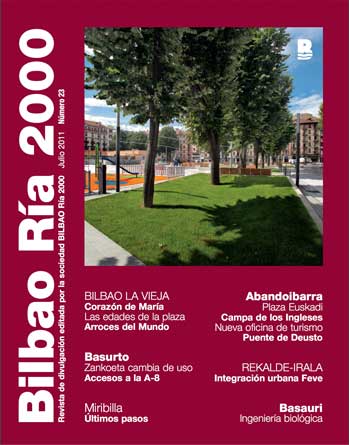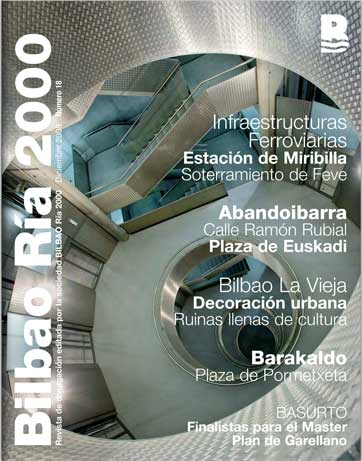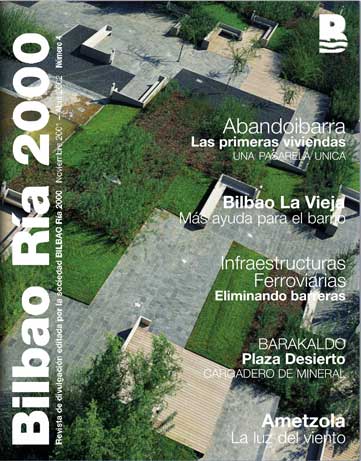BILBAO Ría 2000
Publications
Magazines
Magazine No. 24
Magazine No. 23
Magazine No. 22
Magazine No. 21
Magazine No. 20
Magazine No. 19
Magazine No. 18
Magazine No. 17
Magazine No. 16
Magazine No. 15
Magazine No. 14
Magazine No. 13
Magazine No. 12
Magazine No. 11
Magazine No. 10
Magazine No. 9
Magazine No. 8
Magazine No. 7
Magazine No. 6
Magazine No. 5
Magazine No. 4
Magazine No. 3
Magazine No. 2
Magazine No. 1
Publications

Rekalde. A graphic chronicle of urban integration
This book reviews the work to underground the Feve line as it passes through the Bilbao neighbourhoods of Basurto and Rekalde, carried out by BILBAO Ría 2000.
Throughout its 226 pages, the book takes you on a chronological tour of all the actions carried out in this underground work, with special emphasis on the graphic aspect, which accounts for an important part of its content.
The book, with photographs by José Miguel Llano and designed by Kusbuk, includes a historical review of the Feve line, a technical explanation of the work, notes on the design of the Basurto-Hospital station and various articles related to the work.
In the graphic aspect, in addition to the evolution of the works, there is a section dedicated to the workers who have participated, a summary of the main milestones and a comparison between the before and after in different areas that were underground.
Chronologically, the work began with the laying of the first stone in September 2005 and ended with the inauguration of the area developed by Bilbao City Council on Calle Camino de la Estación in December 2010, with a mention of the work underway to underground the Feve freight line in Rekalde and Irala.

Strolling through Bilbao Old Town
Strolling through Bilbao Old Town” suggests readers take a walk through the oldest parts of Bilbao: El Casco Viejo and Bilbao La Vieja. The publication complements the Historical Signposting Plan undertaken by BILBAO Ría 2000, which includes the installation of six panels and eighty signposts showing some of the most significant aspects of the town.
The work of the Professor of History, Juan Manuel González Cembellín, and the Bachelor of Fine Arts, Raquel Cilla, “Strolling through Bilbao Old Town”, written in Basque and Spanish, consists of 168 pages and has 192 colour illustrations. The book summarises 700 years of history in a didactic way and with the presence of a wealth of graphic material, both historical and contemporary. One of the attractions of this publication is how the original drawings by the architect Jorge Moreno Higuera for the above-mentioned panels have been captured on paper.
The publication includes brief notes summarising the city’s history that accompany and give meaning to the wealth of graphic material that is the central focus and contains the aforementioned original drawings, plans, photographs and reproductions of historical engravings and paintings.

BILBAO, culture as a city project
Symbolised by Frank O. Gehry’s high-profile Guggenheim Museum, Bilbao is flourishing through a major urban project that can be summarised in a series of of points, lines and surfaces -large facilities, transport infrastructure and new neighbourhoods-. Many prestigious firms, such as Norman Foster and Santiago Calatrava, and Basque talents have come together thanks to the expertise of BILBAO Ría 2000; this small team managing the urban project is supported by a partnership with the private sector.
Here we show the projects and methods to serve as a benchmark for European cities that are committed to culture and to the urban project as a boost to economic and social regeneration.

Mineral loading bays in the Bizkaia mining area.
The Sociedad Franco-Belga’s loading bay
BILBAO Ría 2000 is a public company that, for its 10 years of existence, has been working on transforming the land that was once occupied by industry, thus opening up new opportunities for urban and economic development in the Bilbao metropolitan area.
The Galindo area is undergoing a comprehensive rehabilitation process that will make it a new reference point for Barakaldo. It is an area of more than 600 hectares that will be home to housing, new roads, business development, leisure and recreation areas.
If a historian had to point out the key elements of our industrial iconography, he would surely point out the two mineral loading bays still present on the Estuary: the ones that were built and exploited by the companies Franco-Belga and Orconera, the last two of a collection of almost thirty examples through which most of the iron extracted in the mines of Bizkaia was shipped.

























